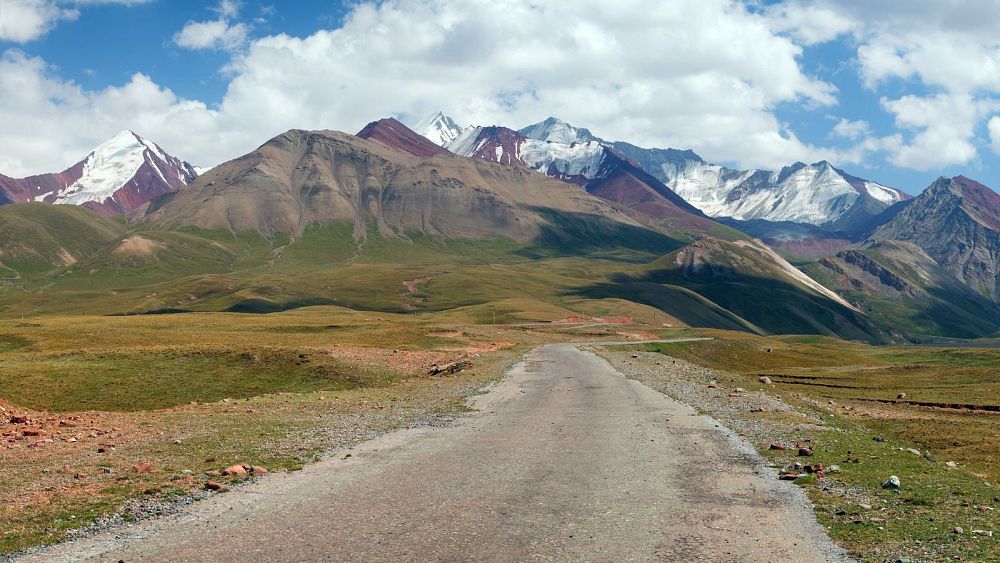The landlocked Central Asian country is home to some of the world’s highest mountains, which remain unknown to the crowds that flock to Everest.
Stretching more than 13,000 kilometers across Tajikistan’s rugged landscape, the Pamir Mountains are a jaw-dropping sight for adventurers who dare to tackle the range’s spectacular peaks.
Nicknamed the “Roof of the World,” the Pamir Mountains offer trekking routes at over 4,000 meters, taking hikers and climbers literally through the clouds.
The core of the isolated, snow-capped mountain range, which extends to Afghanistan, China and Kyrgyzstan, is located in Tajikistan. This makes this landlocked Central Asian country the perfect destination for those wishing to conquer its peaks.
“About 93% of Tajikistan’s territory is mountainous,” Kamoliddin Muminzod, president of the country’s tourism board, tells Euronews Travel. “This condition gives us a good opportunity to develop mountain tourism, which includes adventure tourism, rafting, hiking and much more.”
Tajikistan wants its mountains to be accessible to all types of tourists, both experienced climbers and those who simply want to go on a nice hike.
“You can’t climb to the top of the highest mountain if you’re not an experienced mountaineer, but there are other activities you can do,” says Muminzod.
Contenuti
ToggleWhat can you see in the Pamir Mountains?
The Pamir Mountains are located within a national park recognized as a world heritage site by UNESCO in 2013.
Don’t miss Lake Sarez, created in 1911 by a huge landslide, a remote site reachable only after a long expedition. Or Lake Karakul, the largest lake in the mountain range and in Central Asia.
Due to the harsh conditions of the mountains, with rare rainfall and cold winters, in addition to its incredible heights, the landscape of the Pamir Mountains is quite barren. But you can still encounter some incredible wildlife.
Hikers can hope to spot brown bears, wolves, marmots and, more rarely, snow leopards. Because they are able to blend in so well with the snowy mountain landscape, it would be difficult to spot them.
Ismoil Somoni peak is the highest point in Tajikistan at 7,495 meters, followed by Ibn Sina peak at 7,134 meters, Korzehnevskoi peak at 7,105 meters and Independence peak at 6,940 meters.
Nature lovers should keep in mind that the Pamir Mountains are also home to one of the longest glaciers outside the polar circles: the 77-kilometer-long Fedchenko Glacier. Other glaciers in the Pamir Mountains are currently suffering the impacts of climate change.
What is the best time to visit the Pamir Mountains?
The Pamir Mountains tend to be cold and dry for much of the year, but winter is particularly harsh. The freezing temperatures between November and March would make the visit particularly challenging.
Between spring and summer the temperature is normally around 20 degrees Celsius. Due to the lack of rain this season, hikers never have to worry about having to cancel their plans due to bad weather.
The trekking season usually runs from July to September, when the weather is ideal and the days are long.
How to reach the Pamir mountains
While reaching the Pamir Mountains isn’t easy, travelers are rewarded with one of the most spectacular road trips in the world. There are only two ways to access the mountains: from Dushanbe, the capital of Tajikistan, or from Osh in Kyrgyzstan.
The journey to the Pamirs from Dushanbe takes approximately 16 hours.
Should you hire a guide?
Depending on the activity and its difficulty, you should consider hiring a guide.
Although it is possible to explore the Pamir Mountains on your own following the easier trails, it would be safer to rely on an experienced local guide to climb the peaks of the range.
Where to stay in the Pamir mountains
Hikers and climbers looking to explore the remote landscape of the Pamir Mountains can expect to trek for days over the mountain range, finding only limited signs of civilization.
Those who wish can bring their own tent and camp under the stars in the spectacular landscapes of the Pamir Mountains.
Those seeking solace and fuller immersion with local communities can find homestays and village guesthouses in some of the more fertile valleys.
Image:Getty Images







